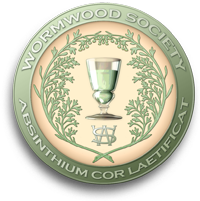
Absinthe: The Rise, Fall and Resurrection of the Green Fairy
Thujone
The particular compound which excited the attention of scientists and critics was thujone, a terpene found in the volatile oil of wormwood—as well as in sage, rosemary, thyme, tansy, white cedar, tarragon, lavender and a number of other herbs and botanicals commonly used in kitchens around the world.
In high enough doses, thujone is a potent neuro-toxin shown to produce hallucinations, epileptiform convulsions, brain damage and renal failure. Fortunately, the trace amounts found in authentic absinthe and other foods are far below what would be considered hazardous. Since virtually any substance is subject to abuse, and any chemical compound consumed in excess will be found to be toxic or damaging, it is likely that thujone was nothing more than the scapegoat sought, found and exploited.
It is also important to remember that, in French, the word “absinthe” may be used for the plant and the essential extracts as well as the drink. This permitted no small amount of abuse by anti-absinthe lobbyists when quoting Magnan’s and other scientists’ findings.
In the end we find that the entire basis for the current dark reputation of absinthe was formed by political manipulation, moralistic propaganda, and the bad science used to serve them.
Absinthe Banned
The work of the temperance leagues and incompetent or dishonest scientists was not without effect. As the problem of alcoholism grew, so did the accompanying crime and other social issues associated with it. Whenever a violent crime was committed, if any connection to absinthe could be made, it was seized upon as proof of the demonic influence of the Green Devil.
This all came to a head in Switzerland in 1905 when a man named Jean Lanfray, in a drunken rage, murdered his pregnant wife and two daughters and then attempted to kill himself. Of course, Lanfray was an absinthiste-—an absinthe addict. It was pointed out that he had had two glasses of absinthe prior to the murders. What was not pointed out was that he was an habitual drunkard who drank any kind of alcohol that he could get his hands on, and that he would consume as much as five liters of wine a day. He had drunk the two absinthes that morning before going to work. He had also drunk a crème de menthe, a cognac, and six glasses of wine at lunch, another glass of wine before leaving work. At home, a cup of coffee with brandy, a liter of wine and then another coffee with marc in it. Undoubtedly it was the absinthe, taken perhaps as much as eight to twelve hours earlier, which pushed him over the edge.
Shortly after the Lanfray incident petitions were circulated and the public began increasingly to adopt the position that absinthe was a menace; a position based on media manipulation and misinformation, and which also fattened the larders of the wine industry.
Absinthe was banned in Switzerland in 1910, in the USA in 1912, and finally in France in 1915. With the Green Fairy in exile and WWI escalating, the spell was broken and the Belle Époque had come to an end.
